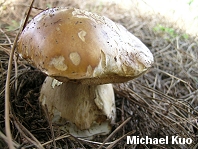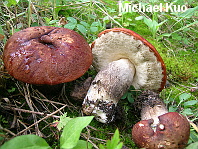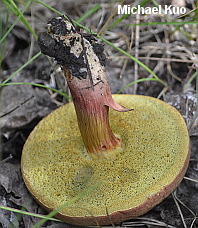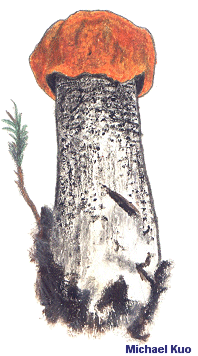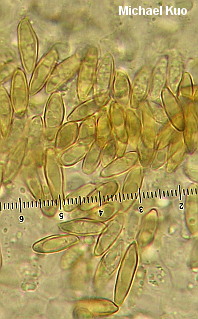References
Arora, D. (2008). California porcini: Three new taxa, observations on their harvest, and the tragedy of no commons. Economic Botany 62: 356–375.
Arora, D. & J. L. Frank (2014). Boletus rubriceps, a new species of porcini from the southwestern USA. North American Fungi 9: 1–11.
Arora, D. & J. L. Frank (2014). Clarifying the butter Boletes: a new genus, Butyriboletus, is established to accommodate Boletus sect. Appendiculati, and six new species are described. Mycologia 106: 464–480.
Ayala-Vásquez, O., R. Valenzuela, E. Aguirre-Acosta, T. Raymundo & J. García-Jiménez (2018). Species of Boletaceae (Boletales, Basidiomycota) with ornamented spores from temperate forests at the state of Oaxaca, Mexico. Studies in Fungi 3: 271–292.
Baroni, T. J. (1978). Chemical spot-test reactions—boletes. Mycologia 70: 1064–1076.
Baroni, T. J. & E. E. Both (1991). Chalciporus piperatoides in North America. Mycologia 83: 559–564.
Baroni, T. J., E. E. Both & A. E. Bessette (1998). Tylopilus rhodoconius, comb. nov.—new records, critical observations, illustrations, and notes on biogeography. Bulletin of the Buffalo Society of Natural Sciences 36: 257–260.
Baroni, T. J. & E. E. Both (1998). Tylopilus violatinctus, a new species of Tylopilus for North America, with comments on other violaceous colored Tylopilus taxa. Bulletin of the Buffalo Society of Natural Sciences 36: 261–264.
Barua, G., T. M. Szaro & T. D. Bruns (1992). Gastrosuillus laricinus is a recent derivative of Suillus grevillei: Molecular evidence. Mycologia 84: 592–597.
Bessette, A. E., E. E. Both, A. R. Bessette, D. L. Dunaway & W. C. Roody (1998). New taxa of boletes from the southern United States. Bulletin of the Buffalo Society of Natural Sciences 36: 233–237.
Bessette, A. E., Roody, W. C. & Bessette, A. R. (2000). North American boletes: A color guide to the fleshy pored mushrooms. China: Syracuse UP. 399 pp.
Beugelsdijk, D.C.M., S. van der Linde, G.C. Zuccarello, H.C. den Bakker, S.G.A. Draisma & M.E. Noordeloos (2008). A phylogenetic study of Boletus section Boletus in Europe. Persoonia 20: 1–7.
Binder, M. & H. Besl (2000). 28S rDNA sequence data and chemotaxonomical analyses on the generic concept of Leccinum (Boletales). In: Associazione Micologica Bresadola, ed. Micologia 2000. Brescia, Italy: Grafica Sette, 75–86.
Binder, M. & A. Bresinsky (2002). Retiboletus, a new genus for a species complex in the Boletaceae producing retipolides. Feddes Repertorium 113: 30–40.
Binder, M. & D. S. Hibbet (2006). Molecular systematics and biological diversification of Boletales. Mycologia 98: 971–981.
Both, E. E. (1993). The boletes of North America: A compendium. Buffalo NY: Buffalo Museum of Science. 436 pp.
Both, E. E. (1998). New taxa of boletes and two boletes with identity problems. Bulletin of the Buffalo Society of Natural Sciences 36: 215–232.
Both, E. E., S. Brown & B. Ortiz-Santana (2009). The second record of the European species, Boletus dupainii, in North America. Bulletin of the Buffalo Society of Natural Sciences 38: 1–4.
Both, E. E. & B. Ortiz-Santana (2010). Clinton, Peck and Frost—the dawn of North American boletology. Bulletin of the Buffalo Society of Natural Sciences 39: 11–28.
Both, E. E. & B. Ortiz-Santana (2012). An annotated index to species and intraspecific taxa of boletes (Mycota: Boletales: Boletaceae) in the Clinton Herbarium of the Buffalo Society of Natural Sciences. Bulletin of the Buffalo Society of Natural Sciences 41: 3–6.
Brundrett, M. C. & B. Kendrick (1987). The relationship between the ash bolete (Boletinellus merulioides) and an aphid parasitic on ash tree roots. Symbiosis 3: 315–320.
Bruns, T. D. & Palmer, J. D. (1989). Evolution of mushroom mitochondrial DNA: Suillus and related genera. Journal of Molecular Evolution 28: 349–362.
Coker, W. C. and Beers, A. H. (1943). The boleti of North Carolina. New York: Dover. 96 pp. (1971 reprint.)
Den Bakker, H. C., B. Gravendeel & T. W. Kuyper (2004a). An ITS phylogeny of Leccinum and an analysis of the evolution of minisatellite-like sequences within ITS1. Mycologia 96: 102–118.
Den Bakker, H. C., G. C. Zuccarello, T. W. Kuyper & M. E. Noordeloos (2004b). Evolution and host specificity in the ectomycorrhizal genus Leccinum. New Phytologist 163: 201–215.
Den Bakker, H. C. & M. E. Noordeloos (2005). A revision of European species of Leccinum Gray and notes on extralimital species. Persoonia 18: 511–587.
Den Baker, H. C., G. C. Zuccarello, Th. W. Kuyper & M. E. Noordeloos (2007). Phylogeographic patterns in Leccinum sect. Scabra and the status of the arctic-alpine species L. rotundifoliae. Mycological Research 111: 663–672.
Dentinger, B. T. M., J. F. Ammirati, E. E. Both, D. E. Desjardin, R. E. Halling, T. W. Henkel, P. -A. Moreau, E. Nagasawa, K. Soytong, A. F. Taylor, R. Watling, J. -M. Moncalvo & D. J. McLaughlin (2010). Molecular phylogenetics of porcini mushrooms (Boletus section Boletus). Molecular Phylogenetics and Evolution 57: 1276–1292.
Dick. E. A. & W. H. Snell (1965). Notes on boletes. XV. Mycologia 57: 448–458.
Farid, A., A. R. Franck, J. Bolin & J. R. Garey (2020). Expansion of the genus Imleria in North America to include Imleria floridana, sp. nov., and Imleria pallida, comb. nov. Mycologia 112: 423–437.
Frank, J. L., N. Siegel, C. Schwarz, B. Araki & E. C. Vellinga (2020). Xerocomellus (Boletaceae) in western North America. Fungal Systematics and Evolution 6: 265–288.
Frost, C. C. (1874). Catalogue of boleti of New England, with descriptions of new species. Bulletin of the Buffalo Society of Natural Science 2: 100–105.
García-Jiménez, J., F. Garza-Ocañas, J. I. de la Fuente, Á. E. Saldivar & O. Ayala-Vásquez (2019). Three new records of Aureoboletus Pouzar (Boletaceae, Boletales) from Mexico. Check List 15: 759–765.
Gelardi, M. (2011). A noteworthy British collection of Xerocomus silwoodensis and comparative overview on the European species of X. subtomentosus complex. Bollettino dell' Associazione Micologica Ecologica Romana 3: 28–38
Grand, L. F. & Smith, A. H. (1971). A previously unrecognized southern species of Boletus. Mycologia 63: 114–117.
Grand, L. F. & Smith, A. H. (1971). A new species of Boletus, section Luridi, from North Carolina. Mycologia 63: 884–888.
Grand, L. F. & Lodge, D. J. (1978). Occurrence of Boletus piedmontensis in North Carolina and Georgia. Mycologia 70: 1267–1268.
Grund, D. W. & Harrison, A. K. (1976). Nova Scotian boletes. Germany: J. Cramer. 283 pp.
Halling, R. E. (1977). California boletes VI. Some unreported species from the Sierra Nevada of California. Mycologia 69: 206–211.
Halling, R. E. (1983). Boletes described by Charles C. Frost. Mycologia 75: 70–92.
Halling, R. E. (1989). A synopsis of Colombian boletes. Mycotaxon 34: 93–114.
Halling, R. E. & E. E. Both (1998). Generic affinity of Boletus separans. Bulletin of the Buffalo Society of Natural Sciences 36: 239–243.
Halling, R. E. & Mueller, G. M. (1999). New boletes from Costa Rica. Mycologia 91: 893–899.
Halling, R. E. (1999). New Leccinums from Costa Rica. Kew Bulletin 54: 747–753.
Halling, R. E. & G. M. Mueller (2003). Leccinum (Boletaceae) in Costa Rica. Mycologia 95: 488–499.
Halling, R. E., T. W. Osmundson & M. A. Neves (2008). Pacific boletes: implications for biogeographic relationships. Mycological Research 112: 437–447.
Halling, R. E., M. Nuhn, T. Osmundson, N. Fechner, J. M. Trappe, K. Soytong, D. Arora, D. S. Hibbett & M. Binder (2012). Affinities of the Boletus chromapes group to Royoungia and the description of two new genera, Harrya and Australopilus. Australian Systematic Botany 25: 418–431.
Halling, R. E., M. Nuhn, N. A. Fechner, T. W. Osmundson, K. Soytong, D. Arora, D. S. Hibbett & M. Binder (2012). Sutorius: a new genus for Boletus eximus. Mycologia 104: 951–961.
Halling, R. E., N. Fechner, M. Nuhn, T. Osmundson, K. Soytong, D. Arora, M. Binder & D. Hibbett (2015). Evolutionary relationships of Heimioporus and Boletellus (Boletales), with an emphasis on Australian taxa including new species and new combinations in Aureoboletus, Hemileccinum and Xerocomus. Australian Systematic Botany 28: 1–22.
Hayward, D. & H. D. Thiers (1984). Gyrodon lividus in California. Mycologia 76: 573–575.
Hills, A. E. (2008). The genus Xerocomus: A personal view, with a key to the British species. Field Mycology 9: 77–96.
Hongo, T. (1974). Notes on Japanese larger fungi (21). Journal of Japanese Botany 49: 294–305.
Janda, V., M. Kriz & M. Kolarik (2019). Butyriboletus regius and Butyriboletus fechtneri: typification of two well-known species. Česká Mykologie 71: 1&ndah;32
Kibby, G. (2006) Leccinum revisited: a new synoptic key to species. Field Mycology 7: 77–87.
Knudsen, H. & A. Taylor (2018). Xerocomus Quél. In Knudsen, H. & J. Vesterholt, eds. Funga Nordica: Agaricoid, boletoid, clavarioid, cyphelloid and gastroid genera. Copenhagen: Nordsvamp. 228–233.
Korhonen, M., J. Hyvönen & T. Ahti (1993). Suillus grevillei and S. clintonianus (Gomphidiaceae), two boletoid fungi associated with Larix. Karstenia 33: 1–9.
Kretzer, A. et al. (1996). Internal transcribed spacer sequences from 38 recognized species of Suillus sensu lato: Phylogenetic and taxonomic implications. Mycologia 88: 776–785.
Klofac, W. (2010). The genus Aureoboletus, a world-wide survey. A contribution to a monographic treatment. Österreichische Zeitschrift für Pilzkunder 19: 133–174.
Klofac, W. (2013). A world-wide key to the genus Suillus. Österreichische Zeitschrift für Pilzkunde 22: 211–278.
Klofac, W. & I. Krisai-Greihuber (2020). Nomenclatural novelties in Boletales. Österreichische Zeitschrift für Pilzkunder 28: 19–21.
Knudsen, H. & A. Taylor (2018). Suillus Adans. In Knudsen, H. & J. Vesterholt, eds. Funga Nordica: Agaricoid, boletoid, clavarioid, cyphelloid and gastroid genera. Copenhagen: Nordsvamp, 203–207.
Korhonen, M., J. Hyvönen & T. Ahti (1993). Suillus grevillei and S. clintonianus (Gomphidiaceae), two boletoid fungi associated with Larix. Karstenia 33: 1–9.
Kretzer, A., Y. Li, T. Szaro & T. D. Bruns (1996). Internal transcribed spacer sequences from 38 recognized species of Suillus sensu lato: Phylogenetic and taxonomic implications. Mycologia 88: 776–785.
Kretzer, A. & Bruns, T. D. (1997). Molecular revisitation of the genus Gastrosuillus. Mycologia 89: 586–589.
Kuo, M., A. S. Methven, A. M. Minnis & R. E. Halling (2013). Studies of North American macrofungi, 1. Validation of Lactarius rubidus comb. nov. and Leccinellum quercophilum sp. nov. Mycotaxon 124: 323–332.
Kuo, M. & B. Ortiz-Santana (2020). Revision of leccinoid fungi, with emphasis on North American taxa, based on molecular and morphological data. Mycologia 112: 197–211.
Lannoy, G. & A. Estades (1995). Monographie des Leccinum d’Europe. La Roche-sur-Foron, France: Federation Mycologique Dauphine-Savoie. 229 pp.
Lavorato, C. (2000). Suillus lakei var. calabrus var. nov. In: Associazione Micologica Bresadola, ed. Micologia 2000. Brescia, Italy: Grafica Sette, 285–288.
Lebel, T., T. Orihara & N. Maekawa (2012). The sequestrate genus Rosbeeva T. Lebel & Orihara gen. nov. (Boletaceae) from Australasia and Japan: a new species and new combinations. Fungal Diversity 52: 49–71.
Murrill, W. A. (1909). The Boletaceae of North America I. Mycologia 1: 4–18.
Nguyen, N. H., J. F. Kerekes, E. C. Vellinga & T. D. Bruns (2012). Synonymy of Suillus imitatus, the imitator of two species within the S. caerulescens/ponderosus complex. Mycotaxon 122: 389–398.
Nguyen, N. H., E. C. Vellinga, T. D. Bruns & P. G. Kennedy (2016). Phylogenetic assessment of global Suillus ITS sequences supports morphologically defined species and reveals synonymous and undescribed taxa. Mycologia 108: 1216–1228.
Noordeloos, M. E. (2018). Suillus S. F. Gray. In Noordeloos, M. E., T. W. Kuyper, I. Somhorst & E. C. Vellinga, eds. Flora Agaricina Neerlandica: Critical revisions of families of agarics and boleti occurring in the Netherlands. Volume 7. Orrigio, Italy: Candusso Editrice. 208–225.
Nouhra, E., M. A. Castellano & J. M. Trappe (2002). NATS truffle and truffle-like fungi 9: Gastroboletus molinai sp. nov. (Boletaceae, Basidiomycota), with a revised key to the species of Gastroboletus. Mycotaxon 83: 409–414.
Nuhn, M. E., M. Binder, A. F. S. Taylor, R. E. Halling & D. S. Hibbett (2013). Phylogenetic overview of the Boletinae. Fungal Biology 117: 479–511.
Orihara, T., F. Sawada, M. Yamato, C. Tanaka, N. Shimomura, M. Hashiya & K. Iwase (2010). Taxonomic reconsideration of a sequestrate fungus, Octaviana columellidera, with the proposal of a new genus, Heliogaster, and its phylogenetic relationships in the Boletales. Mycologia 102: 108–121.
Orihara, T., M. E. Smith, Z. -W. Ge & N. Maekawa (2012). Rossbeevera yunnanensis (Boletaceae, Boletales), a new sequestrate species from southern China. Mycotaxon 120: 139–147.
Orihara, T., M. E. Smith, N. Shimomura, K. Iwase & N. Maekawa (2012). Diversity and systematics of the sequestrate genus Octaviana in Japan: two new subgenera and eleven new species. Persoonia 28: 85–112.
Ortiz-Santana, B., D. J. Lodge, T. J. Baroni & E. E. Both (2007). Boletes from Belize and the Dominican Republic. Fungal Diversity 27: 247–416.
Ortiz-Santana, B., D. P. Lewis & E. E. Both (2009). A new Boletus from North America. Mycotaxon 110: 211–217.
Ortiz-Santana, B. & E. E. Both (2011). A preliminary survey of the genus Buchwaldoboletus. Bulletin of the Buffalo Society of Natural Sciences 40: 1–14.
Osmundson, T. W. & R. E. Halling (2010). Tylopilus oradivensis sp. nov.: a newly described member of the Tylopilus balloui complex from Costa Rica. Mycotaxon 113: 475–483.
Palm, M. E. & Stewart, E. L. (1984). Suillus neoalbidipes: A new species for Suillus albidipes. Mycologia 76: 433–438.
Palm, M. E. & Stewart, E. L. (1986). Typification and nomenclature of selected Suillus species. Mycologia 78: 325–333.
Peintner, U., H. Ladurner & G. Simonini (2003). Xerocomus cisalpinus sp. nov., and the delimitation of species in the X. chrysenteron complex based on morphology and rDNA-LSU sequences. Mycological Research 107: 659–679.
Petersen, R. H., K. W. Hughes, S. Adamcik, Z. Tkalcec & A. Mesic (2012). Typification of three European species epithets attributable to Strobilomyces (Boletales). Czech Mycology 64: 141–163.
Pietras, M., M. Litkowiec & J. Golebiewska (2018). Current and potential distribution of the ectomycorrhizal fungus Suillus lakei ((Murrill) A. H. Sm. & Thiers) in its invasion range. Mycorrhiza 28: 467–475.
Pomerleau, R. & Smith, A. H. (1962). Fuscoboletinus, a new genus of the Boletales. Brittonia 14: 156–171.
Redhead, S. A. & R. Watling (1979). A new psammophilic Leccinum. Canadian Journal of Botany 57: 117–119.
Selosse, M. A. (2003). Founder effect in a young Leccinum duriusculum (Schultzer) Singer population. Mycorrhiza 13: 143–149.
Singer, R. (1945). New Boletaceae from Florida (a preliminary communication). Mycologia 37: 797–799.
Singer, R. (1945). The boletinae of Florida. Germany: J. Cramer. 126 pp. (1977 reprint.)
Singer, R. (1978). Keys for the identification of the species of Agaricales I. Sydowia 30: 192–279.
Singer, R. & R. Williams (1992). Some boletes from Florida. Mycologia 84: 724–728.
Smith, A. H. & R. Singer (1959). Studies on secotiaceous fungi—IV: Gastroboletus, Truncocolumella, and Chamonixia. Brittonia 11: 205–223.
Smith, A. H. & Thiers, H. D. (1964). A contribution toward a monograph of North American species of Suillus. Ann Arbor: U Michigan. 116 pp.
Smith, A. H., Thiers, H. D. & Miller, O. K. (1965). The species of Suillus and Fuscoboletinus of the Priest River Experimental Forest and vicinity, Priest River, Idaho. Lloydia 28: 120–138.
Smith, A. H., H. D. Thiers & R. Watling (1966). A preliminary account of the North American species of Leccinum, Section Leccinum. The Michigan Botanist 5: 131–178.
Smith, A. H. & Thiers, H. D. (1967). Comments on Suillus amabilis and Suillus lakei. Mycologia 59: 361–367.
Smith, A. H., H. D. Thiers & R. Watling (1967). A preliminary account of the North American species of Leccinum, Sections Luteoscabra and Scabra. The Michigan Botanist 6: 107–154.
Smith, A. H. & Thiers, H. D. (1968). Notes on boletes—I. 1. The generic position of Boletus subglabripes and Boletus chromapes. 2. A comparison of four species of Tylopilus. Mycologia 60: 943–954.
Smith, A. H., H. D. Thiers & R. Watling (1968). Notes on species of Leccinum. I. Additions to Section Leccinum. Lloydia 31: 252–267.
Smith, A. H. & Thiers, H. D. (1971). The boletes of Michigan. Ann Arbor: U Michigan P. 428 pp.
Smith, A. H., Smith, H. V. & Weber, N. S. (1981). How to know the non-gilled mushrooms. Dubuque, Iowa: Wm. C. Brown. 324 pp.
Snell, W. H., A. H. Smith & L. R. Hesler (1940). New species of boleti from Cades Cove in the Great Smokies. Journal of the Elisa Mitchell Society 56: 325–328.
Snell, W. H. & E. A. Dick (1941). Notes on boletes. VI. Mycologia 33: 23–37.
Snell, W. H. (1941). The genera of Boletaceae. Mycologia 33: 415–423.
Snell, W. H. (1945). Notes on boletes. VII. Mycologia 37: 374–388.
Snell, W. H. & E. A. Dick (1961). Notes on boletes. XIV. Mycologia 53: 228–236.
Snell, W. H. & Dick, E. A. (1970). The boleti of northeastern North America. Germany: J. Cramer. 115 pp.
Šutara, J. (1991). Pseudoboletus, a new genus of Boletales. Česká Mykologie 45: 1–9.
Šutara, J. (2008). Xerocomus s. l. in the light of the present state of knowledge. Česká Mykologie 60: 29–62.
Šutara, J. (2014). Anatomical structure of pores in European species of genera Boletus s. str. and Butyriboletus (Boletaceae). Česká Mykologie 66: 157–170.
Taylor, A. F. S., A. E. Hills, G. Simonini, E. E. Both & U. Eberhardt (2006). Detection of species within the Xerocomus subtomentosus complex in Europe using rDNA-ITS sequences. Mycological Research 110: 276–287.
Taylor, A. F. S., A. E. Hills, G. Simonini & U. Eberhardt (2007). Xerocomus silwoodensis sp. nov., a new species within the European X. subtomentosus complex. Mycological Research 111: 403–408.
Thiers, H. D. (1963). The bolete flora of the Gulf Coastal Plain. I. The Strobilomyceteae. Journal of the Elisha Mitchell Scientific Society 79: 32–41.
Thiers, H. D. & A. H. Smith (1966). An undescribed bolete in the B. rubellus group. The Michigan Botanist 5: 117–118.
Thiers, H. D. & J. M. Trappe (1969). Studies in the genus Gastroboletus. Brittonia 21: 244–254.
Thiers, H. D. (1971). California boletes. IV. The genus Leccinum. Mycologia 63: 261–276.
Thiers, H. D. (1975). The boletes of California (online reprint of California mushrooms: A field guide to the boletes). Retrieved February, 2020 from the MykoWeb website: http://www.mykoweb.com/boletes/index.html
Thiers, H. D. (1976). Boletes of the southwestern United States. Mycotaxon 3: 261–273.
Thiers, H. D. (1979). The genus Suillus in the western United States. Mycotaxon 9: 285–296.
Treu, R. (1993). Studies on Boletus Section Luridi. Mycotaxon 47: 367–377.
Vellinga, E. C., B. de la Houssaye, R. -L. Brace & V. Evenson (2006). Paragyrodon sphaerosporus: A Mid-western endemic? McIlvainea 16: 19–21.
Weber, N. S. & Smith, A. H. (1985). A field guide to southern mushrooms. Ann Arbor: U Michigan P. 280 pp.
Wells, V. L. & P. E. Kempton (1967). Studies on the fleshy fungi of Alaska. I. Lloydia 30: 258–268.
Wells, V. L. & P. E. Kempton (1975). New and interesting fungi from Alaska. Nova Hedwigia 51: 347–358.
Wolfe, C. B. (1979). Austroboletus and Tylopilus subgenus Porphyrellus with emphasis on North American taxa. Germany: J. Cramer. 148 pp.
Wolfe, C. B. (1981). Type studies in Tylopilus. I. Taxa described by Charles H. Peck. Sydowia 34: 199–213.
Wolfe, C. B. (1983). Taxonomic and nomenclatural notes on boletes. Mycotaxon 17: 398–404.
Wolfe, C. B. (1983). Type studies in Tylopilus. II. Taxa described by William A. Murrill. Mycologia 75: 699–706.
Wolfe, C. B. (1986). Type studies in Tylopilus. III. Taxa described by Walter H. Snell, Esther A. Dick, and co-workers. Mycologia 78: 22–31.
Wolfe, C. B. & R. E. Halling (1989). Tylopilus griseocarneus, a new species from the North American Atlantic and Gulf Coastal plain. Mycologia 81: 342–346.
Wolfe, C. B. (1990). Type studies in Tylopilus. IV. Taxa described by Rolf Singer. 1. Mycotaxon 38: 187–200.
Wolfe, C. B. (1991). Type studies in Tylopilus (Boletaceae). V. Taxa described by Alexander H. Smith, Harry D. Thiers, and Samuel J. Mazzer. Canadian Journal of Botany 69: 1833–1838.
Wolfe, C. B. & N. L. Bougher (1993). Systematics, mycogeography, and evolutionary history of Tylopilus subg. Roseoscabra in Australia elucidated by comparison with Asian and American species. Australian Systematic Botany 6: 187–213.
Wu, G., B. Feng, J. Xu, X.-T. Zhu, Y.-C. Li, N.-K. Zeng, Md. I. Hosen & Z. L. Yang (2014), Molecular phylogenetic analyses redefine seven major clades and reveal 22 new generic clades in the fungal family Boletaceae. Fungal Diversity 69: 93–115.
Zeng, N. -K., Z. -Q. Liang, G. Wu, Y. -C. Li & Z. L. Yang (2016). The genus Retiboletus in China. Mycologia 108: 363–380.
Zhang, M., T. -H. Li, M. Gelardi, B. Song & X. J. Zhong (2017). A new species and a new combination of Caloboletus from China. Phytotaxa 309: 118–126.
Zhang, M., T. -H. Li, C. -Q. Wang, N. -K. Zeng & W. -Q. Deng (2019). Phylogenetic overview of Aureoboletus (Boletaceae, Boletales), with descriptions of six new species from China. MycoKeys 61: 111–145.
Zhang, R., G. M. Mueller, X. -F. Shi & P. -G. Liu (2017). Two new species in the Suillus spraguei complex from China. Mycologia 109: 296–307.
Zhao, K., G. Wu, B. Feng & Z. L. Yang (2014). Molecular phylogeny of Caloboletus (Boletaceae) and a new species in East Asia. Mycological Progress 13: 1127–1136.
Zhao, K., G. Wu, R. E. Halling & Z. L. Yang (2015). Three new combinations of Butyriboletus (Boletaceae) Phytotaxa 234: 51–62.
This site contains no information about the edibility or toxicity of mushrooms.
Cite this page as:
Kuo, M. (2013, December). The boletes. Retrieved from the MushroomExpert.Com Web site: http://www.mushroomexpert.com/boletes.html

